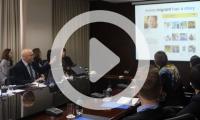Skills
Recent Activity

A presentation of the first-ever U.S. estimates on the economic costs of brain waste for highly skilled immigrants, their families, and the U.S. economy. The researchers discuss their findings in terms of the billions of dollars in forgone earnings and unrealized taxes when college-educated immigrants are relegated to low-skilled work.

Nearly 2 million college-educated immigrants in the United States are stuck in low-skilled jobs or are unemployed—a phenomenon known as brain waste. In this brief video, MPI researchers discuss their key findings on immigrant skill underutilization and the resulting billions of dollars in unrealized wages and forgone federal, state, and local tax receipts.

A webinar discussing fact sheets that compare the characteristics of immigrant and native-born residents that are relevant to understanding needs for adult education and workforce training services in the United States and the ten states with the largest immigrant populations.

This briefing in Bangkok launches the MPI-IOM Issue in Brief, Shortage amid Surplus: Emigration and Human Capital Development in the Philippines, which reviews the impacts of the Philippines' successful labor export policy on skills development and human capital growth within the country. While Filipino migrant workers contribute significantly to the national economy with the remittances they send home (over US $27 billion in 2014), this reliance on exporting labor raises an important question: Has the nation’s focus on preparing workers to leave compromised human capital development at home?

A discussion on how governments and societies can retain their most valuable workers, turn emigration challenges into opportunities, and capture more of the potential benefits of emigration.
Pages
Recent Activity
In this World of Migration podcast episode, MPI Senior Fellow Michael Fix speaks with Senior Policy Analyst Julia Gelatt about the fiscal impacts of immigration, the importance of immigrant integration, how a greater focus on credential recognition could allow immigrants to more fully utilize the academic and professional skills they bring with them, and much more.























